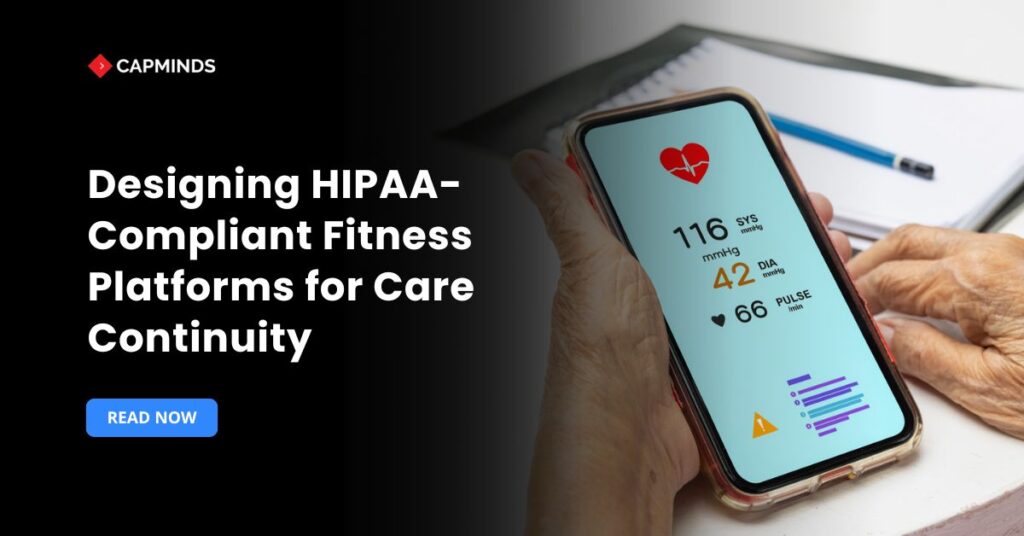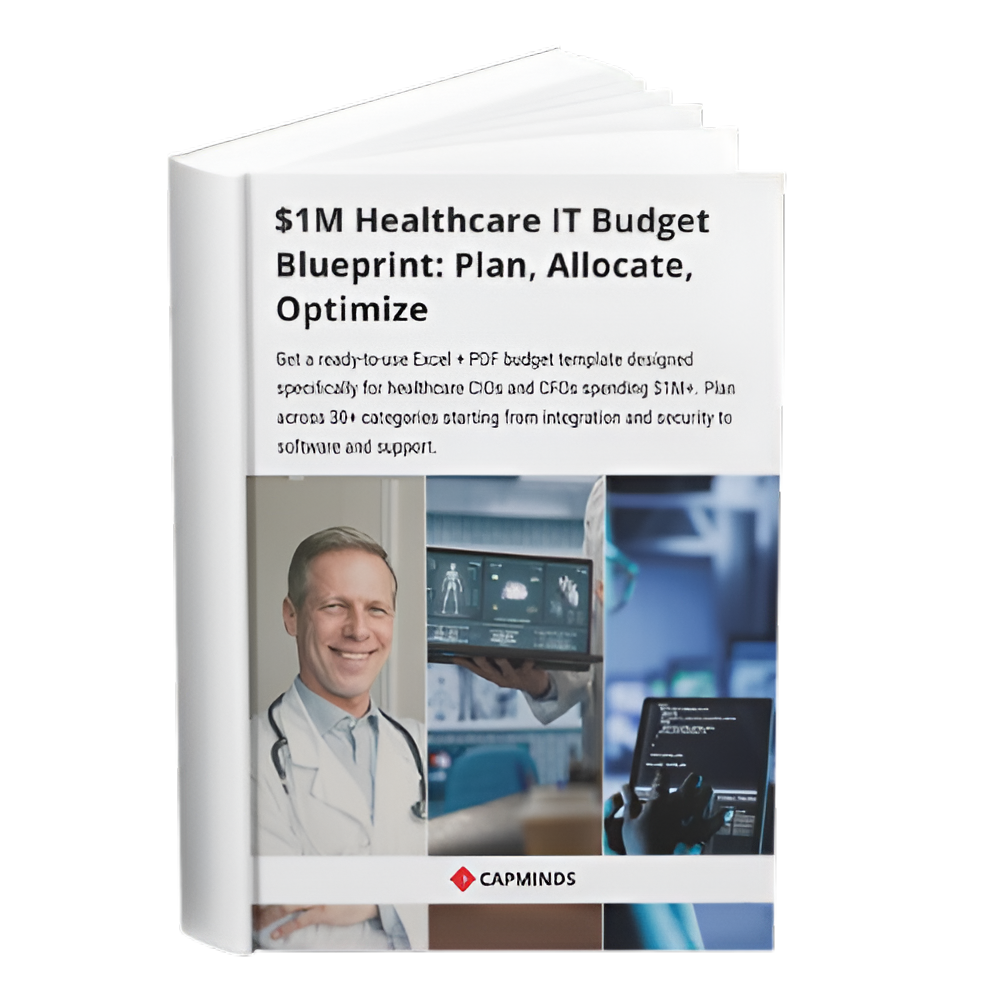Designing HIPAA-Compliant Fitness Platforms for Care Continuity
As fitness and wellness apps blend into healthcare ecosystems, compliance has become critical. Personal health data must be securely handled by digital-health innovators and fitness-tech providers. In HIPAA-compliant software development, protecting sensitive information isn’t optional—it’s essential.
The stakes are high. In January 2024, 8.8 million health records were breached, underscoring the need for strong safeguards. Non-compliance brings steep fines up to $68,000 per violation—and erodes patient trust.
The upside? Platforms designed with security and privacy at the core meet legal requirements and build user confidence. This guide explains how to create custom healthcare software solutions for fitness and wellness use cases—supporting secure care continuity, compliance, and lasting trust.
Understanding HIPAA Compliance for Fitness & Wellness Apps
Not every health app or fitness tracker is automatically HIPAA compliant. HIPAA regulates covered entities and their business connections. These organizations manage protected health information on behalf of healthcare providers or insurers.
If your fitness platform keeps or transmits identifiable health information for a healthcare provider or insurer, you should be HIPAA compliant.
- For example, a workout app used by a hospital to monitor patient rehab would be a business associate. It must protect PHI accordingly.
- A consumer-only fitness app with no connection to medical services may not trigger HIPAA.
- Data a user creates for personal use is generally not covered by HIPAA.
- However, as soon as that data is shared with doctors, clinics, or insurers as part of care, it becomes regulated under HIPAA.
Protected Health Information is at the core of HIPAA. PHI includes any health-related information that can identify an individual. This isn’t limited to medical records. If fitness information is linked to an individual’s identity, it may be considered PHI. When connected to a particular user’s health profile or medical record, seemingly innocuous measures like heart rate or step count turn into PHI.
Related: Building Fitness & Wellness Apps for Population Health: What Large Providers Should Know
Treat information from your wellness platform as PHI if it has the potential to be linked to a person’s health. Be sure to protect it appropriately. This guarantees that when your platform is used in a healthcare process, you don’t miss any sensitive information covered by HIPAA. Additionally, it’s critical to differentiate between clinical and wellness use cases.
Generally, unless a provider uses it, HIPAA does not control data that an individual tracks for their well-being. Many contemporary fitness programs, however, conflate this distinction by incorporating healthcare.
- For instance, by providing a telehealth coaching component or exchanging exercise logs with a doctor.
- You must design your platform for complete HIPAA compliance if it enables this type of interaction between healthcare and fitness for care continuity.
- HIPAA regulations are applicable whenever your app handles identifiable health information on behalf of a covered entity. This entails putting policies and procedures in place to protect the privacy and security of the data.
Key Best Practices in HIPAA-Compliant Platform Design
Designing a HIPAA-compliant fitness platform entails more than simply implementing a privacy policy. It entails integrating security and privacy into your application.
The HIPAA Security Rule establishes safeguards for electronic PHI. These safeguards include administrative, physical, and technological measures. Meeting these standards is critical. Here are some essential best practices and design considerations to ensure digital health compliance on your platform:
1. Identify & Limit PHI from the Start
Begin by mapping out the data that your program collects. Determine which elements are PHI. Perform a thorough data audit. Include user profiles, fitness metrics, health questionnaire results, and other pertinent information. Mark any data that could reveal a user’s health state.
- Once you’ve identified PHI, follow the rule of minimal necessary.
- Collect and store only the health information required for your feature set.
- Minimizing PHI in your system helps to limit risk exposure.
Ensure that consumers understand what health data is being gathered. Explain why data is being collected. This transparency fosters confidence and is frequently legally necessary.
2. Build in Robust Data Security Measures
HIPAA demands strong technical measures to prevent unauthorized access to health information.
- Encrypt data at rest and in transit. Utilize contemporary encryption standards.
- Encryption ensures that even if a breach happens, the data is unreadable by outsiders.
- Enforce stringent access constraints. Users and staff should only have access to data that is necessary for their roles. Secure critical functions with strong authentication.
Choose a secure platform and architecture from the beginning. This helps to fulfill HIPAA’s mandate.
PHI must be securely stored, accessed, and distributed.
This includes encrypting data, controlling access, and keeping track of access. Security must be a major component of your app design.
3. Use HIPAA-Compliant Infrastructure & Partners
If your app uses cloud services, analytics tools, or other third-party components, ensure that they are compliant. Only employ cloud hosting, databases, or APIs that are HIPAA-compliant.
- Sign Business Associate Agreements with any vendor or partner who may handle protected health information on your behalf.
- A BAA is a legal contract. It requires the vendor to satisfy HIPAA security criteria. The seller must also notify of any breaches.
- Check that the BAA includes procedures for data protection, breach notification, and proper usage of PHI.
- For example, if your fitness platform sends data to a cloud EHR system, the system must protect the information.
If your platform relies on a third-party messaging API for coach-patient interactions, that provider must also protect the data. Integrate only with trusted, compliant partners. This will protect your users and keep your compliance intact.
4. Implement Audit Trails and Monitoring
HIPAA mandates complete audit logs for any PHI-related access or actions. Your platform should automatically track who accesses and alters health data. This comprises users, coaches, and system administrators. Keep track of critical events in a safe and tamper-proof manner.
These audit trails aid in tracking unwanted access. They are critical for forensic analysis in the event of a suspected breach. Regularly go over these logs. Consider using automated monitoring solutions that notify you of unusual activity. Audit controls serve more than just compliance purposes.
They also help you identify problems early on and demonstrate accountability. Maintaining records of PHI access is critical. It facilitates the tracking of breaches and the maintenance of responsibility.
5. Protect Data in All Communications
A typical issue is disclosing PHI via notifications or integrations. Never send PHI using insecure means. For example, avoid plain-text email reminders or in-app push alerts with health information. If you need to share health information with users, use safe, encrypted messaging within your app or a HIPAA-compliant email/service.
When your platform distributes data with external systems or providers, employ secure APIs that require proper authentication. Make sure all mobile app data kept on a user’s device is secured. If possible, ensure that the data can be erased remotely if the device is lost. You can prevent critical information from being accidentally leaked by securing all data exchange channels.
6. Obtain User Consent and Authorizations
Privacy by design entails honoring users’ expectations and rights when dealing with their health information. In a fitness-medical hybrid platform, consumers must explicitly agree to any data sharing with healthcare professionals or third parties.
If your platform collaborates with doctors or draws information from medical records, seek HIPAA authorization from the user. This authorizes you to use or disclose their PHI for that purpose.
You can include this consent in onboarding or as a separate opt-in when contacting a clinic.
State which data will be shared, with whom, and for what reason. Beyond legal documents, include privacy options that give people control over their data.
Empowering users with control is consistent with HIPAA patient rights and promotes trust.
Related: 10 Must-Have Features for Successful Healthcare Mobile Apps
7. Plan for Breaches and Incident Response
Even with good prevention, you must be prepared for the worst. Create a clear breach notice and response plan. Ensure that it complies with HIPAA’s Breach Notification Rule requirements. The plan should include identifying and preventing a breach.
- It should also patch the issue and promptly notify affected individuals and authorities if unencrypted PHI has been compromised.
- Have an incident response team or a protocol in place.
- This way, if something goes wrong, your team can respond swiftly and limit the damage.
Perform periodic risk assessments and penetration tests.
These tests will assist you in proactively identifying and addressing issues. By planning, you display diligence. This can mitigate the effects of any security issue.
8. Ensure Interoperability for Care Continuity
A fitness platform that integrates with healthcare aims to support continuity of care. The goal is to ensure that patient wellness data is safely transmitted to those who need it, hence improving health outcomes.
To make this easier, build your platform with standardized data formats and compatibility in mind.
- For example, utilize HL7 FHIR or another healthcare data standard.
- These standards enable your app to exchange data with EHR systems in a standardized and secure manner.
- Use secure APIs with role-based access controls. This guarantees that healthcare providers have access to a participant’s relevant fitness data for their therapy.
- Transmit only the information required for care. This aligns with the disclosure restriction premise of HIPAA.
Care coordination is made easy when the fitness-to-healthcare link is implemented properly.
For instance, a physician can modify exercise recommendations and monitor a cardiac rehab patient’s daily step counts using your app.
As long as adequate controls are in place, HIPAA permits such data interchange for medical reasons.
Repetitive testing is avoided, and care coordination is enhanced through secure PHI sharing. This improves care continuity.
You can comply with regulations and become a valuable provider of care continuity technology by building your platform to connect safely and smoothly with the healthcare ecosystem.
Secure Your Fitness Platform’s Future with CapMinds Services
At CapMinds, we understand the importance of HIPAA compliance for fitness and wellness platforms.
As the line between fitness apps and healthcare blurs, it’s crucial to integrate the highest standards of privacy and security to protect patient data and ensure smooth care continuity.
Our team provides comprehensive digital health technology services and solutions, enabling you to design and develop custom healthcare apps that comply with HIPAA requirements and foster user trust.
Here’s how CapMinds can support you:
- Custom Healthcare App Development: We build apps that integrate fitness and healthcare seamlessly while maintaining security.
- Data Privacy & Security Solutions: Implement robust security measures, encryption, and secure APIs to safeguard sensitive health information.
- HIPAA Compliance Consulting: Ensure your platform complies with all regulatory requirements, from audit trails to breach response protocols.
- Healthcare Integration: Leverage HL7 FHIR and other standards to enable interoperability with healthcare systems and enhance care coordination.
Start building your HIPAA-compliant fitness platform today with CapMinds to ensure privacy, security, and seamless care integration.




